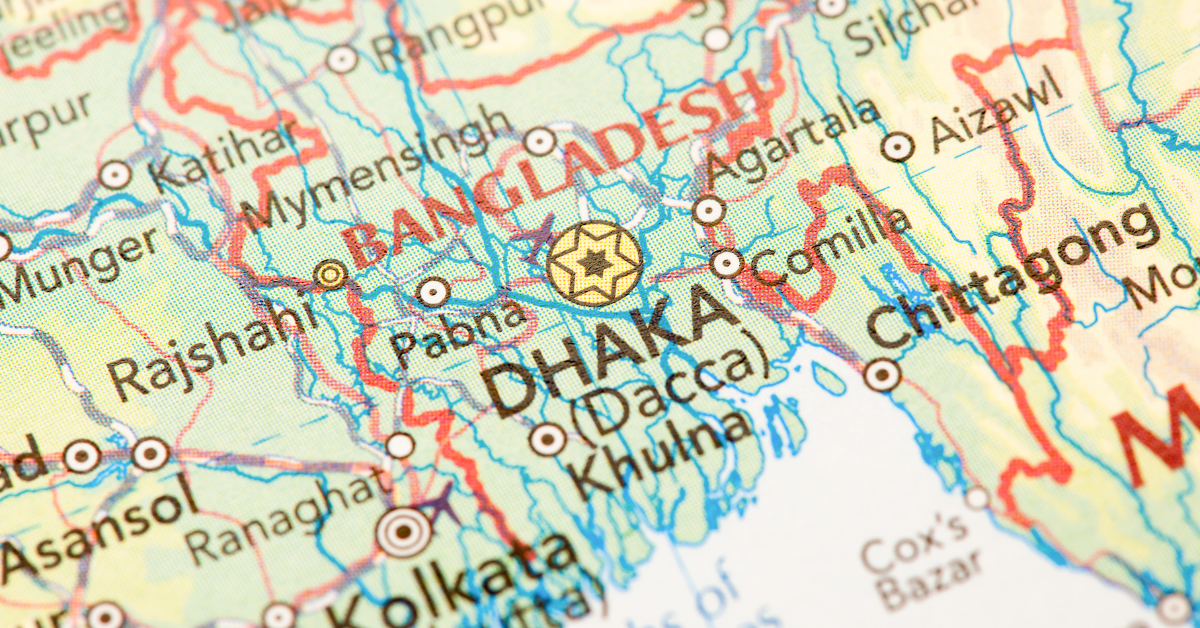Dhaka, the capital of Bangladesh, is written in katakana as ダッカ in Japanese, but in Chinese it is written with characters as 达卡. This notation is not about meaning but about sound, making it a phonetic transcription. In this article, we explore why the city’s name takes this form and how to explain it to foreigners in a simple way.
What Does the Chinese Character Notation “达卡” Mean?
In Chinese, “达卡” is a phonetic transcription of the capital Dhaka.
- “达” (dá) means “to reach” or “to arrive”
- “卡” (kǎ) means “card” or “to block,” but here it simply reflects the sound
The two characters were not chosen for their meaning but for their sound resemblance to “Dhaka.”
| Character | Pronunciation (Chinese) | Main Meaning | Role for Dhaka |
|---|---|---|---|
| 达 | dá | to reach | corresponds to “Da” |
| 卡 | kǎ | card, block | corresponds to “-kha” |
Difference from the Japanese “ダッカ”
In Japanese, foreign place names are usually written in katakana. For this reason, Dhaka is written as “ダッカ,” and kanji are not used.
In contrast, Chinese has a tradition of transcribing foreign place names with Chinese characters. This is why “Dhaka” becomes “达卡” in Chinese texts.
| Language | Writing Method | Dhaka Notation | Feature |
|---|---|---|---|
| Japanese | Katakana | ダッカ | Strictly phonetic, no meaning attached |
| Chinese | Chinese characters (phonetic) | 达卡 | Uses character sounds to approximate foreign pronunciation |
Why Are Foreign Place Names Written in Chinese Characters?
The practice exists because Chinese does not have an alphabetic writing system. Instead, characters with similar sounds are chosen to reproduce foreign names.
Some representative examples:
| City (English) | Chinese Notation (Simplified) | Japanese Notation |
|---|---|---|
| Dhaka | 达卡 | ダッカ |
| London | 伦敦 | ロンドン |
| Paris | 巴黎 | パリ |
| New York | 纽约 | ニューヨーク |
As these examples show, the purpose is not to convey meaning, but to reproduce sound.
Impression of the Notation “达卡”
Foreigners might think that “达卡” literally means “reaching card,” but this is a misunderstanding. “达卡” has no semantic connection to the city; it is purely a phonetic representation.
| Notation | Visual Impression | Actual Meaning |
|---|---|---|
| ダッカ (Japanese) | Represents the city’s name directly | A phonetic transcription of Dhaka |
| 达卡 (Chinese) | Looks like “reach + card” | A phonetic transcription only, no semantic relation |
Historical Background and Cultural Differences
China has long recorded foreign place names in Chinese characters, dating back to the Silk Road. For instance, Kashmir became “喀什米尔,” and Greece is written as “希腊.”
In Japan, however, katakana became the standard for foreign place names after the Meiji era. Modern Japanese readers immediately understand “ダッカ” as a city name, but “达卡” might feel unfamiliar.
This difference reflects not only writing conventions but also the historical development of each language’s culture.
Real Usage Examples
The notation “达卡” is frequently used in Chinese newspapers and maps. In international news, one might see “达卡市发生抗议活动” (Protests occurred in Dhaka City).
For learners or researchers reading Chinese, it is important to connect “达卡” with the familiar Japanese “ダッカ” to avoid confusion.
| Context | Japanese | Chinese |
|---|---|---|
| News Article | ダッカで抗議活動 (Protests in Dhaka) | 达卡市发生抗议活动 |
| Map Label | ダッカ | 达卡 |
| Government Document | ダッカ首都圏 (Dhaka Metropolitan Area) | 达卡首都圈 |
Key Points When Explaining to Foreigners
When explaining “达卡” to foreigners, emphasize these points:
- In Japanese, “Dhaka” is written as katakana ダッカ, with no meaning attached.
- In Chinese, “达卡” is used, but again it is only phonetic.
- The meanings of “达” and “卡” are irrelevant in this context.
This helps learners understand that there is no hidden meaning to “达卡.”
Conclusion
The reason Dhaka is written as “达卡” is due to the Chinese tradition of phonetic transcription.
- Japanese uses katakana “ダッカ.”
- Chinese uses “达卡” to approximate the sound.
- “达卡” conveys no semantic meaning, only sound.
By understanding this, readers can grasp not only the notation of Dhaka but also the broader cultural differences between Japanese and Chinese. This knowledge is useful for interpreting international texts and deepening cross-cultural understanding.






